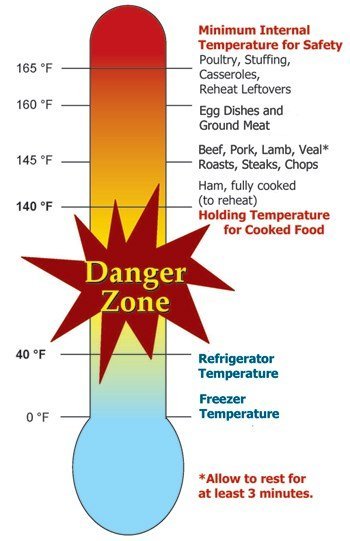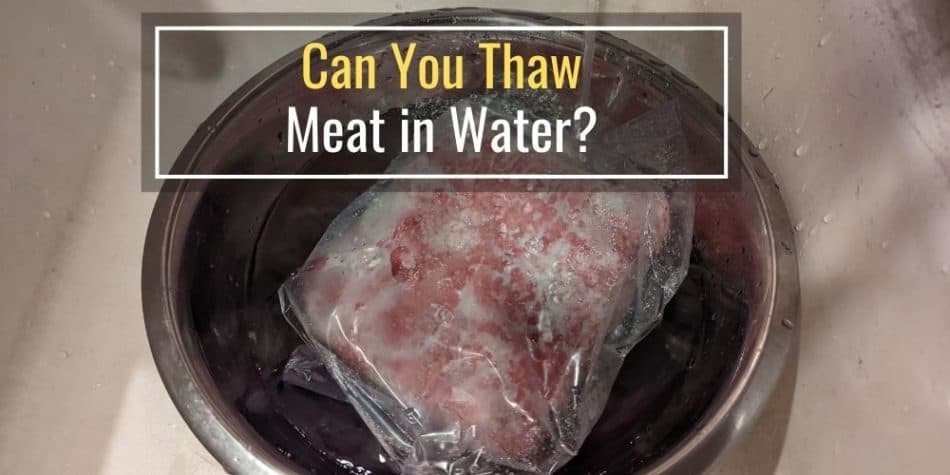We’ve all been there. You plan a BBQ for the weekend or invite folks over for that big dinner but forget to thaw the meat out overnight.
Now you’re left with a big hunk of frozen meat and a hungry crowd so what can you do?
Can you thaw meat in water to quickly defrost it?
Frozen meat can be defrosted in cold water in order to thaw quickly. Ideally, the meat should be in a vacuum sealed or plastic wrapped bag to avoid water soaking into the meat. However, meat that gets wet when thawing is still safe to cook and eat.
In fact, you can simply dry off any excess water or cook the wet meat that has thawed out.
The thawed meat is safe to cook and eat as long as any part of the meat has not been sitting at temperatures of 40°F to 140°F for more than 2 hours.
Now let’s cover why you should thaw meat in cold water if you need to thaw the meat quickly.
Meat Thaws Faster in Water vs Air
The main reason to thaw meat in water is that the frozen meat will thaw faster in water vs meat thawing in air.
Water conducts heat better than air so placing plastic wrapped meat in a bowl of cold water will thaw the meat faster than letting the meat sit on the kitchen counter.
Keep in mind that cold water is still warmer than frozen meat so the cold or cool water will still help thaw the meat out quickly.
Make sure to avoid using warm or hot water when thawing meat.
Use Cold Water When Thawing Meat
When thawing meat with water, you should only use cool or cold water.
The reason why you never want to thaw meat with hot water or room temperature air is because of the “Danger Zone.”
The USDA warns that any meat that is left in the Danger Zone of 40°F to 140°F for 2 or more hours will be unsafe to eat due to bacteria growth.

So any meat thawing out at room temperature or with warm water will have the surface of the meat thaw faster than the middle.
By the time the middle of the meat has thawed, the surface of the meat will have spent a lot of time within the Danger Zone of 40°F to 140°F.
In fact, the USDA Food Safety reiterates that hot food must remain above 140°F and cold food must remain below 40°F
So it is very important for food to not sit between 40°F to 140°F otherwise the food will be unsafe to consume.
Never Use Warm or Hot Water For Thawing Meat
Any meat that is thawed with warm or hot water will thaw unevenly and may become unsafe to eat if left in warm or hot water for 2 or more hours. Always use cold water instead of hot water when thawing meat in water.
The reason why you should never use warm or hot water for thawing meat is because of the Danger Zone.
Bacteria rapidly multiply in the Danger Zone of temperatures between 40°F to 140°F so as soon as the outside of the meat reaches 40°F then the bacteria will begin to multiply while the inside of the meat will remain frozen.
So always use cold water when defrosting meat in water.
Does Thawing Meat in Water Ruin it?
A common question I hear is if thawing meat in water will ruin it.
I think some folks are scared that if water seeps into the meat then the meat will be inedible.
However, thawing meat in cold water is the safest and fastest way to thaw meat. Even if water seeps into the meat while defrosting, the meat can be patted dry or simply cooked normally and the water will evaporate.
The only way thawing meat in water can ruin it is if you use warm or hot water. If warm or hot water is used to thaw meat then the outside of the meat may spoil before the inside of the meat is thawed.
Keep in mind that bacteria rapidly multiply at temperatures of 40°F to 140°F so as soon as the outside of the meat reaches that temperature then the clock is ticking.
The FDA recommends that meat not be kept at temperatures of 40°F to 140°F for more than 2 hours so make sure to use thawed meat before that time.
If you use cold water then the outside of the meat will remain at temperatures below 40°F and still be food safe while the inside of the meat thaws.
3 Methods For Thawing Frozen Meat
Thawing frozen meat can be tricky, but there are three common methods for thawing frozen meat.
Using cold water is the fastest and safest way to thaw meat but there are 2 other methods as well.
1. Thaw Frozen Meat In Cold Water
To speed up the defrosting process of your frozen meat, place the meat in a bowl of cold or cool water.
Tips For Thawing Frozen Meat In Water
- The meat should be in a leak-proof package or plastic bag.
- Submerge the sealed meat in cold tap water. Never use the warm or hot water as this can cause harmful bacteria to start growing.
- Change the water every 30 minutes to speed up the thawing process.
- Gently poke the meat with your fingers to see if the meat has thawed out. If you feel ice crystals or stiffness, give the meat more time to thaw out.
- To avoid bacterial growth, make sure that the thawed meat is cooked as soon as it comes out of the water bowl.
Note: If you use the cold water method to defrost your frozen meat, it should be cooked immediately after thawing.
Never refreeze raw meat that has been defrosted in cold water. Once cooked, though, you can then freeze the cooked meat if you want.
2. Thaw Frozen Meat In The Fridge
The easiest way to defrost frozen meat is by placing the frozen meat overnight in the refrigerator.
However, thawing frozen meat in the refrigerator is the slowest but safest way to thaw frozen meat so plan ahead.
Tips For Thawing Frozen Meat In The Fridge
- Place the frozen meat in a container or on a plate so that any excess juices do not drip on other foods in the fridge.
- Place the frozen meat in a refrigerator and ensure that the fridge temperature is set to 40°F or below.
- When thawing frozen meat in the fridge, allow for about 12 hours for ground meat and up to 2 days for bone in meat and whole roasts.
Note: You should always keep your frozen meat in the fridge after thawing it out.
Here are the timelines of how long frozen meat that has thawed out in the fridge can be safely stored:
| Frozen Meat Type | Fridge Timeline After Thawing |
|---|---|
| Ground Meat | 1 to 2 days |
| Bone-in and Whole Roasts | 3 to 5 days |
So generally frozen meat that has been thawed in the fridge can last in the fridge for an additional 1 to 2 days for ground meat and an additional 3 to 5 days for whole roasts and bone-in meat.
Meat that has been thawed out in the fridge can be placed back in the freezer and refrozen if your plans change and you no longer want to cook the food.
3. Thaw Frozen Meat In Microwave
Microwaves are a quick way to defrost frozen meat. However, there are a few things to keep in mind before you place frozen meat in the microwave.
Tips For Thawing Frozen Meat In The Microwave
- First before thawing frozen meat in the microwave, check the power level settings and use a lower power setting.
- Place the frozen meat in a container or on a plate to capture the excess juices as the meat thaws in the microwave.
- Thaw the frozen meat for 2 to 3 minutes before flipping the meat over and continuing until thawed.
Note: Frozen meat should always be cooked immediately after defrosting in a microwave.
Is Thawing Meat in the Sink Safe?
Another common question I hear is if it is safe to thaw meat in the sink.
Thawing meat in the sink is safe. If the sink is empty then the meat is just thawing with air which will take longer than if you use cold water to thaw the meat. A better method is to plug up the sink’s drain and fill the sink with cold water or place the frozen meat in a bowl of water if the meat fits in a bowl.
Although meat can defrost in the sink, the meat must not reach an internal temperature of 40°F to 140°F for more than 2 hours otherwise the meat can spoil.
So the outside of the meat may spoil while the inside of the meat remains frozen if the meat is thawing in warm air.
Does Defrosting Steak in Water Ruin it?
Defrosting steak in water does not ruin it. In fact, defrosting a steak as quickly as possible will help retain the steak’s texture. Similar to how flash freezing a steak is better than allowing a steak to slowly freeze, quickly defrosting a steak is better than allowing the steak to slowly defrost.
Keep in mind that using a microwave to quickly defrost a steak may also cook the steak which can make the steak mushier.
So grab a bowl of cold water and allow the steak to quickly thaw. Make sure to change the water with more cold water every 30 minutes until the steak has defrosted completely.
Can Chicken Be Defrosted in Warm Water?
Never defrost chicken with warm or hot water! It is not safe. The warm water will start to cook the outside of the meat before the middle is thawed and bacteria will begin to form which can spoil the chicken.
Always use cool or cold water when defrosting chicken in water in order to avoid the chicken from sitting in the Danger Zone for 2 or more hours.
The Danger Zone is when any part of the chicken reaches a temperature of 40°F to 140°F. In the Danger Zone, bacteria will rapidly multiply which can cause the chicken to spoil.
So do NOT thaw chicken in warm or hot water.
See this article to learn more about how to safely thaw chicken and if chicken goes bad if you see water in the chicken.
Can Unwrapped Meat Be Placed in Water?
Although it’s commonly recommended to place frozen meat wrapped in plastic in water, unwrapped frozen meat can also be placed directly in water to defrost.
Unwrapped meat that is placed in cold water will still thaw out safely. However, the unwrapped meat will also absorb some water. Once defrosted, the wet meat can be cooked normally as the water will evaporate.
If you plan on frying the meat in oil then make sure to dry the meat as best as you can before placing the meat in oil.
Water and oil do not mix so make sure to give the wet meat a few extra pats of a paper towel before frying it.
One Last Word
Frozen meat can be defrosted in cold water. Whether the meat is wrapped or unwrapped, cold water will thaw the meat out quickly and safely. Any meat that gets wet while defrosting can still be cooked normally since the water will evaporate.
Just make sure to use cold water and never use warm or hot water when defrosting meat in water.

